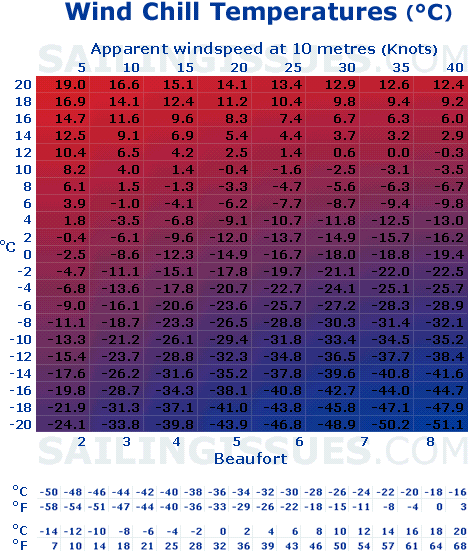Wind chill
![]()
Wind chill forecast
The term wind chill goes back to the Antarctic explorer Paul A. Siple, who coined it in a study: "Adaptation of the Explorer to the Climate of Antarctica".In 1940 Siple and Charles F. Passel conducted experiments on the time needed to freeze 250 grams of water in a plastic cylinder that was exposed to the elements. The three parameters involved are:
- the initial temperature of the water;
- the outside temperature;
- and the wind speed.
Definition: Wind chill accounts for loss of heat when warm air around a body is replaced with colder air. The factor is an indication of the effect of the combination of air temperature and wind speed on human comfort and safety.
The ability to forecast wind chill is especially important to yachtsmen since:
- offshore weather forecasts rarely include a wind chill factor;
- both the wind speed and the apparent wind speed are likely to differ from the forecast true wind speed;
- the nature of sailing implies that the duration of exposure to wind chill can not be predicted;
- the threat of hypothermia can be anticipated by using the factor.

ET = 0.045(7.1766 x √KNOTS + 10.45 - 0.5145 x KNOTS)(Celsius - 33.0) + 33.0
Forecasts made with these equations are reasonably sufficient, though work is being done at this very moment to obtain a better index or factor.
Current inadequacies include:
- the Siple and Passel experiment did not take into account that the water was stored in a container with properties of its own;
- there's no heat being generated in a water filled object, whereas the human body is constantly generating heat.
- the original experiment uses wind speed at 10 metres above ground.
- the current wind chill index also ignores other environmental factors such as sun shine, air humidity or precipitation;
- the equations are not valid above 40 knots and below 5 knots!
Conclusion: For your safety: anticipate and use the equivalent temperature to adequately forecast wind chill.